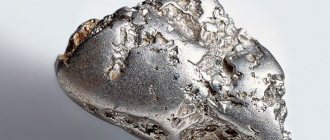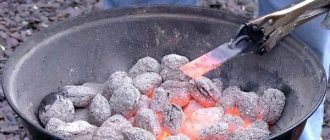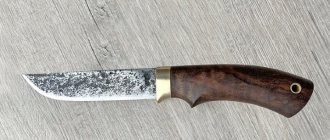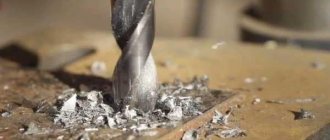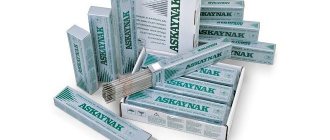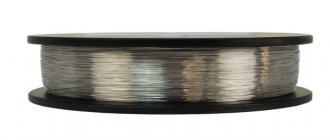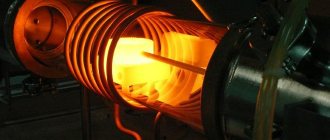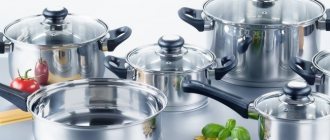Profit Steel
Stainless steel is a popular material in the food industry, mechanical engineering, construction and other industries. Such steel...
Stainless steel is a popular material in the food industry, mechanical engineering, construction and other industries. This steel is corrosion-resistant, durable, and parts made from it do not require additional processing. Before purchasing it, it is important to check whether this metal is a stainless steel - this can be done in several ways without involving specialists.
Stainless steel is distinguished by properties, type, marking and other parameters. The assessment will require a sample of steel that can be tested. Before checking, you need to study the main features of such metals. Let's talk about this in more detail.
PROPERTIES AND CHARACTERISTICS OF STAINLESS STEEL
How to define stainless steel ? Stainless steel gained its relevance due to a number of positive properties:
- Resistance to aggressive environmental influences;
- High wear resistance, due to which the service life of the products is more than ten years;
- Thermal resistance to sudden temperature changes;
- High level of resistance to corrosion and other types of destruction;
- Environmental Safety;
- Aesthetically attractive appearance;
- Easy to use and maintain.
Speaking about what stainless steel is and how to define stainless steel , we can say that it is the result of a successful mixture of steel and impurities that enhance its properties. Such impurities are the main component that prevents the formation of rust and premature aging of products. The more impurities, the longer the service life of the steel in general.
The main additional components are:
- Copper;
- Nickel;
- Molybdenum;
- Chromium;
- Manganese;
- Titanium.
Steel and stainless steel differences
Lorem Ipsum is simply dummy text of the printing and typesetting industry.
Lorem Ipsum has been the industry's standard dummy text ever since the 1500s, when an unknown printer took a galley of type and scrambled it to make a type specimen book.
It has survived not only five centuries, but also the leap into electronic typesetting, remaining essentially unchanged.
It was popularized in the 1960s with the release of Letraset sheets containing Lorem Ipsum passages, and more recently with desktop publishing software Aldus PageMaker including versions of Lorem Ipsum.
This material does not address the question of which steel is “better.”
This is an outdated formulation, which is decades old, and it is incorrect: for each case the choice is different.
Therefore, we will take a simple and unbiased look at the characteristics of both steels and their suitability for specific purposes.
Here we will use the single term “carbon steel” for medium and high carbon types. They differ from each other, but when compared with the so-called stainless steel, this difference is not important to us.
Simple and accessible about carbon and stainless steel
Let's start by clarifying that the established terminology does not very accurately reflect the very essence of the confrontation: the name “carbon” speaks about the composition of the steel, and “stainless” about its ability to resist corrosion, that is, the concepts are, in principle, not very comparable.
Hiroo Itou knife, made using Damascus technology from a stainless alloy. Does not corrode, but its cutting properties are not as good as carbon
What do we actually have?
- All steel contains some amount of carbon . Accordingly, carbon is to a greater extent, but this element is also present in the so-called stainless steel.
- Almost any steel will rust . Stainless steel too (under very harsh conditions).
Why do these materials rust at different rates?
- The iron in carbon steel oxidizes quickly when the carbon comes into contact with oxygen in air or water.
- Stainless steel contains additives (chromium, molybdenum) that make it more resistant to oxidation and, accordingly, corrosion.
The ability or inability to resist corrosion (rust) is the main and fundamental difference between one steel and another. But there are others that are no less important to choose.
Shirogami carbon steel Santoku Almighty knife: requires a little more careful care, but has excellent cutting properties
Ability to absorb odors
Carbon steel itself has a pleasant smell (especially when clean and freshly sharpened), but it quickly absorbs foreign odors.
If we plan wood with a carbon knife, this is even great, but for cutting food it is not very good: the “aroma” of onions or smoked fish will take a long time to wash off the tool.
There are no such problems with stainless steel; it itself is also odorless. For kitchen knives this is a definite plus.
Sharpening
With the same amount of carbon, blades made of corrosion-resistant steels will be more difficult to sharpen due to increased wear resistance.
Therefore, editing blades made of high-carbon, corrosion-resistant steel will require a special tool: a fine-grained water stone or a ceramic finishing rod.
Carbon steel blades, on the contrary, can be edited even with ordinary chef's grinder.
The sharpness achieved in this case, according to practitioners, far exceeds the sharpness of edges made from corrosion-resistant analogues, although it is somewhat inferior to them in durability and wear resistance.
Simply put, a carbon blade is easier to sharpen, edits easier, and cuts better than a stainless steel counterpart, but is inferior in corrosion resistance and longevity of sharpness.
Easy to care for
Both steels definitely require regular cleaning, straightening, sharpening and proper storage.
Moreover, if you really do this constantly, then care in both cases will be simple; but carbon steel is still more sensitive to “inattention”.
Stop caring for high-carbon and stainless steel at the same time, and the former will most likely “revenge” with the appearance of rust.
Cutting properties
Here high-carbon steel definitely wins.
Due to its more pliable structure, it is more sensitive to sharpening, and a cutting edge made of high-carbon steel can be much thinner than one made of stainless steel. And this determines, as they say, “sharpness.”
The aesthetic side of the issue
- Stainless steel does not require additional protection against corrosion, so it is often simply polished. But high-carbon steel ends up looking much more diverse, since a variety of processing methods are used for blades made from it: their purpose is functional, but they also “give” the steel individuality. For example, bluing gives the blade an elegant black color, blackwash coating gives an unusual gray-green tint and thousands of micro-scratches, powder coating gives a matte texture. In principle, the same can be done with stainless steel, but this is not usually practiced.
- Sooner or later, a dark, uniform coating forms on the carbon, which naturally protects the blade from further oxidation; Whether we like this unauthorized coloring of the blade or not is an individual question. Nothing like this happens with stainless steel.
There are discrepancies regarding all of the listed characteristics both on forums and in the literature (especially regarding sharpening - both the labor costs for it and the time that the blade holds it). The fact is that in practice, few people test pure steel of one type or another: most often the blade is treated in some way either from corrosion or from mechanical damage. This greatly distorts the objective picture.
An important point: the problem of corrosion in carbon steel can be solved by treating the blade, but the problem of cutting properties in stainless steel has not yet been completely resolved.
***
If we are ready to regularly care for the knife, that is, keep it clean and dry, then a carbon steel blade is suitable for many purposes - it will give us much more comfortable work due to the “sharp” blade. If we just need a reliable kitchen or hunting knife, which we are not willing to devote a lot of time to, we should choose stainless steel.
On sale
Food grade stainless steel: grade and application features
Food grade stainless steel, as stainless steel is abbreviated to be used for the production of products that come into contact with food and liquids during their operation, is a material with a special chemical composition. The properties of this metal, represented by various grades, determine a fairly wide scope of its application.
Stainless steel sheet grade 08Х18Н10 (AISI 304) polished in film
Areas of application
Particularly high demands are placed on the materials used in the manufacture of various products, containers, containers, pipelines and equipment used in the food industry.
This is explained by the fact that such materials, during operation, not only constantly come into contact with liquid and moist environments, but are also exposed to high temperatures, as well as chemically aggressive substances.
Conventional stainless steel is not always able to withstand the conditions in which food products are stored, transported and processed, despite the fact that it is highly resistant to corrosion. That is why specialists have developed special stainless steels classified as food grade.
Food manufacturers use stainless steel pipes, which are connected with appropriate fittings that meet the requirements of the DIN 11850 standard.
Food grade stainless steel has a number of advantages, among which the following are worth highlighting:
- compliance with strict hygienic and toxicological requirements;
- aesthetically attractive appearance;
- ease of maintenance;
- environmental Safety;
- strength and wear resistance;
- exceptional resistance to various types of aggressive environments;
- compliance with the requirements for the dissolution of heavy metals in the working environment.
Not only a specialist, but also any housewife knows that the most convenient to care for and beautiful are those pots and cutlery that are made of stainless steel.
TYPES OF STAINLESS STEEL
Based on the percentage composition of the main additives, it is customary to distinguish stainless steel from the following types:
Austenitic steels. They contain at least 20% chromium and 4.5% nickel.
Duplex steels. Their chromium content reaches 25%, 1.5% nickel and a slight admixture of nitrogen.
Ferritic steels. Up to 29% chromium is allowed in their composition.
Martensitic steels. Their chromium content is insignificant, no more than 13%, and nickel maximum 4%.
Multicomponent steels. Minimal amounts of chromium and nickel and include a wide range of other enhancing impurities.
Chrome is the main component that simplifies cold deformation, increases the service life of products, and gives an attractive appearance.
Despite the presence of a sufficient number of nuances, questions often arise: how to identify stainless steel, how to distinguish stainless steel from ordinary metal, and how to test stainless steel for quality components . To carry out a distinctive test in everyday conditions, when it is not possible to conduct a serious hardware examination, improvised means are used.
How to distinguish stainless steel from other types of steel
In appearance, all steel grades are almost identical, but at the same time they have different technical characteristics. This means that products made from different types of steel behave differently. To distinguish stainless steel from another grade of steel, you can use several methods:
- Use of nitric acid. This chemical liquid helps distinguish stainless steel from carbon steel. If you apply a few drops to the surface of the steel, a reaction will begin in which caustic steam will be released. This reaction is typical for carbon steel; no changes will occur with stainless steel.
- Check the reflection on the surface. Stainless steel has bluish-yellow tints on its surface.
- Marking. Steel products are always marked with the type and grade of material used. If the numbers are preceded by the letters “STAINLESS”, this means the use of alloy steel.
These simple tips will help you accurately determine the presence of stainless steel.
HOW TO IDENTIFY STAINLESS STEEL: 13 WAYS
Identifying stainless steel using a magnet
Stainless steel does not allow magnetization due to the action of Futko currents. But this technique does not always give the correct result, since iron and martensitic alloys have magnetic properties, and therefore, using a magnet, it is possible to reliably determine only austenitic-iron alloys, which contain a high percentage of nickel and chromium. In other words, it is impossible to 100% identify stainless steel with a magnet, but you can recognize its subtype.
Saline solution
The essence of the method of determining stainless steel with a saline solution is to identify susceptibility to corrosion. A strong saline solution serves as a good provocateur of corrosive destruction. For this purpose, the product to be checked is immersed in a saline solution for a day. Stainless steel, having a high degree of resistance to such aggressive environments, will remain undamaged by corrosion.
Slice method
An incision is made using improvised means. The color of the cut will help distinguish stainless steel from brass, which is similar in color. In the case of the latter, the cut will have a yellow tint. While stainless steel will remain light gray.
Determination of stainless steel with copper sulfate
The top layer is sanded using sandpaper. After which the surface of the stainless steel is treated with a solution of copper sulfate. In this case, the definition of stainless steel, as in the case of the above methods, the stainless steel will not change its external characteristics.
Physical method for determining stainless steel
How to check stainless steel physically?
The method is based on knowledge of the law on the volume of displaced fluid. Stainless steel placed in a container of water will displace a different amount of water than the metal can displace. To do this, you need to know the mass of the product, the mass of the displaced liquid, and have a table of weight differences on hand.
Marking
The marking indicates the properties characteristic of a given material. Based on these properties, you can understand how to identify and distinguish stainless steel from ordinary metal.
Blank Slate Method
Stainless steel does not leave marks from tight contact, while aluminum will give noticeable gray stripes.
Thermal conductivity
For aluminum, unlike stainless steel, it is much higher. In this regard, water in an aluminum container will boil much faster.
Aggressive environments.
When in contact with alkaline and acidic environments, the surface of stainless steel will remain unchanged. Spots will appear on the surface of the aluminum.
Reaction with nitric acid
A few drops of acid reacting with any carbon steel will cause the formation of corrosive fumes. Stainless steel will not react even if the surface is damaged.
Light ebb
The surface of stainless steel gives a yellowish-blue tint.
A mixture of hydrogen peroxide and 20% sulfide
Such a mixture applied to a cut will cause significant darkening visible to the eye if a non-ferrous metal has interacted with the reagent.
Hole
Drilling a hole will help distinguish stainless steel from duralumin by the appearance of the chips.
Identifying stainless steel using a spark
How to identify stainless steel using a spark? That's how:
- V (volume) of carbon in steel has a direct relationship with the number of flashes and sparks;
- The hue of the sparks gives information about the structure of the metal (if they are lightish white, then most likely it is steel with a low carbon content);
- If the sparks have a very bright light shine, this means that the material contains a large amount of titanium.
To conduct such a test to determine stainless steel, you need to start the process of grinding the material with a grinder, and sparks and flashes, as mentioned above, will provide the necessary information.
To carry out the test, an angle grinder (grinder) is required. Start grinding the surface of the steel and observe the reaction. The color, length and shape of the sparks will help you accurately determine metal or stainless steel.
A separate point is worth highlighting the differences between food-grade stainless steel and technical stainless steel. Due to the fact that cookware made from this type of steel is in high demand, such differences are quite relevant. The surface of food-grade stainless steel is distinguished by high quality processing, giving it smoothness. Even matte surfaces visually and to the touch do not have even the slightest defects or protrusions. As a rule, much more metal impurities are added to steel for this purpose. This is due to regular exposure to aggressive environments. The listed properties and requirements also apply to medical products.
In addition to all of the above, markings can provide a large portion of information about the steel from which the product is made.
Stainless steel or carbon. Which knife steel is better? Choosing
Let's look at the characteristics of the two most common materials for knives - carbon steel and stainless steel.
The concept of carbon steel, in our particular case, combines medium and high carbon types. Of course, they are different and have different performance properties, but for our review today this is not significant. For those who like to argue and prove their point of view, let’s say right away that the article will not contain a final summary of which steel is better. You will be asked to use them for specific purposes.
I repeat once again - it is not correct to compare them - each job has its own good one.
General concepts
Once again, this opposition is a comparison between warm and round. When they say “carbon,” they mean its composition; “stainless” means the material’s ability to resist corrosion. Therefore, it is difficult to compare them.
Besides:
- According to the manufacturing technology , any steel
, and by the way stainless steel too,
contains
a certain amount
of carbon
a. It’s just that there is much more of it in the “carbon” one than in others. - Any
(yes any)
steel is subject to corrosion
. It’s just that for one it will require more time and certain harsh conditions, and some are covered with a film against water mist.
What determines the rate of metal corrosion: Corrosion is the oxidation of a material under the influence of oxygen. Carbon steel contains components that are more susceptible to this process. To slow down the process, metals (chromium, molybdenum), so-called additives, are added to the composition of stainless steel, which are practically not susceptible to oxidation.
It turns out that the main difference between one steel and another is the ability to resist corrosion. But there are others, more about them below.
Criteria for comparison
Odor absorption
Carbon steel, especially freshly sharpened steel, has a pleasant smell. But due to its porous structure, it strongly absorbs odors. This is normal as long as it smells like a forest, but if you use a knife in the kitchen, after some time the aroma will be more than unpleasant. To get rid of it, you will have to make a lot of effort.
Stainless steel, due to its structure, is less susceptible to absorbing odors, which makes it more desirable in the kitchen.
Sharpening and cutting
Corrosion-resistant steel contains a large number of additives to impart resistance to oxidation, wear resistance, etc. Therefore, sharpening and straightening such knives is quite complicated and requires special equipment.
Carbon steel, on the contrary, can be sharpened quite simply with ordinary musat and a thinner cutting edge can be made. This gives it good cutting properties. Therefore, according to this criterion, a knife made of carbon steel is superior to its colleague, but, unfortunately, not for a long time.
Care
For any knife to function properly, it must be periodically cleaned, trimmed and sharpened. You also need to take care of proper storage, away from cutlery and chemicals. But due to its composition, a device made of carbon steel is more capricious. A stainless steel knife is more unpretentious and does not require careful daily care.
Product appearance
Due to various processing methods and additives, carbon steel products have their own “individuality”. For example, blued steel has a noble black color; after blackwash coating, the blade acquires a greenish tint; various powder coatings give the coating a matte finish.
If desired, stainless steel products can be subjected to all these procedures, but, as a rule, this is not done.
Also, after some time, a thin dark film forms on the surface - a natural protection of carbon steel from corrosion. This also gives the blade an aesthetic appearance.
We anticipate your objections. We know that in the literature and on specialized forums there are different interpretations of all the evaluation criteria given in the article. And the opinions of those arguing are diametrically opposed.
Especially many copies were broken regarding sharpening and the ability to hold it on various blades. The fact is that pure steel, without additional processing, is practically not used for the manufacture of blades.
And these influences distort the overall picture.
By the way, the problem of corrosion of carbon steel is partially solved by treating it with an anticorrosive agent, but no treatment will improve the cutting properties of stainless steel.
Summary
With proper care, compliance with certain operating rules, timely editing and period, a carbon steel knife will solve most problems in the kitchen. Due to its good cutting properties and easy sharpening, it is more unique and convenient in household chores. And its appearance is pleasing to the eye.
If you want to get a simple, reliable multifunctional tool that can be used with equal efficiency both in the forest and in the kitchen, then opt for a stainless steel blade.
Here's some more interesting material on knives:
- TOP 5 best knives for hunting
- Damascus steel. Myths and reality
- Choosing steel for a knife
- TOP 5 incomprehensible and useless knives from domestic manufacturers
Other interesting articles:
- In the USA, bunkers are growing by leaps and bounds. Who builds them and why?
- How Alyoshka built an outpost in Chechnya.
- Devices for detecting enemy aircraft of the last century. What they were like.
- Photos of grandiose reconstructions of the Second World War
- Military exercises in the Soviet Union. chronicle: how it happened.
STAINLESS STEEL MARKINGS
There are five types of basic markings:
- 08Х18Н10. Dishes made from such material are allowed for use in the food industry. However, exposure to caustic soda is not allowed.
- 08Х13. One of the most popular grades of steel, most often used in the manufacture of kitchen utensils. Such dishes can be heated to almost any temperature, and can also be stored in refrigerators and freezers.
- 20Х13-40Х13. This steel is used to make sinks and dishes. It copes well with temperature changes, is plastic and resistant to mechanical damage.
- 12X13. Steel products with this marking are used in the wine and alcohol industries.
- 08Х17. This steel has the highest heat resistance and good thermal conductivity. Pans made from this type of stainless steel are in high demand.
conclusions
Stainless steel is divided into several types depending on its composition - the more additives it contains, the higher its quality. All these standards are reflected by markings, according to which the material is classified into a certain group and used for the manufacture of various products. Stainless steel is mainly used in the food industry, in medicine, for the production of spare parts for machines and parts for construction.
You can check the quality of stainless steel yourself - visually, using chemical solutions or physical impact. All these methods are inaccurate and for a full assessment it is better to use professional tests. Purchasing material from a professional company guarantees the purchase of products of proven quality.
STAINLESS STEEL QUALITY ASSESSMENT
Assessment of the quality characteristics of stainless steel depends on various parameters, such as the amount of additives, method of connection, etc... After welding at the seams, stainless steel loses its resistance to corrosion, which can lead to the formation of rust and then to its destruction. Painted stainless steel will need to be cleaned of rust and re-polished, which will cause the steel to lose its resistance to moisture. To evaluate stainless steel in advance, you need to resort to a salt solution: if the material is of high quality, there will be no stains on the steel.
RESULT: HOW TO IDENTIFY STAINLESS STEEL
Thus, the task of how to identify and distinguish stainless steel from any other types of metals and steels seems quite possible even without the use of serious industrial expert measures. It is enough to remember and apply at least some of the above methods, which provide completely objective information on the distinctive features. If doubts remain, it is better to turn to expert data. Especially when it comes to medical or food products. By the way, many people are also tormented by the question: is it possible to weld stainless steel to ferrous metal? In this article we will break everything down.
Stainless and carbon steel: who needs both types and why | read on Tojiro website
This material does not address the question of which steel is “better.” This is an outdated formulation, which is decades old, and it is incorrect: for each case the choice is different. Therefore, we will take a simple and unbiased look at the characteristics of both steels and their suitability for specific purposes.
Here we will use the single term “carbon steel” for medium and high carbon types. They differ from each other, but when compared with the so-called stainless steel, this difference is not important to us.
